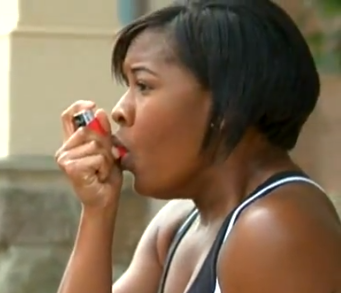(Part of an occasional series.)
There
are several ways of measuring risks. Two of the most commonly used are absolute
risk and relative risk.
They’re easily explained, and being able to recognize what they mean can help
you interpret all kinds of scientific data, especially medical studies and
advertisements.
Absolute risk is the overall proportion of a group likely to have a certain outcome. For example: on average, 9.9 percent of children between the ages of zero and 17 in Connecticut were afflicted with asthma during 2001-2005, according to the National Health Interview Survey (NHIS), conducted by the Centers for Disease Control.

Screenshot from Living With and Managing Asthma; an educational video by the Heart, Lung and Blood Institute. Public domain image.
The absolute risk is 9.9: for every 1,000 children surveyed, 99 of them had
asthma. Another way to phrase it is to say that if you were to pick a random
child from Connecticut during the first half of the decade, there was a 9.9
percent chance that child had asthma.
Absolute risk has major limitations, though. The most obvious drawback is that
it offers little or no context. It’s fine to say that such-and-such number of
people have a given disease, but what we really want to know is why some people
have it and others don’t. Absolute risk doesn’t give us much guidance here.
Relative risk (also sometimes called the "risk ratio") gives us the
ability to pin down some of the differences between groups by calculating the
statistical difference of their individual probabilities.
Relative risk tells us how much more likely one group is to get a disease than
another. After all, people live in wildly divergent circumstances, and any
variable (or combination) can potentially influence their health.
If two groups have significantly dissimilar risks, then there is at least one
variable increasing the risk in one group (or decreasing it in the other). Once
we know the differences, we can narrow our search for causes.
In the case of the NHIS asthma rates, we can compare the data between states.
It turns out that there was a spectrum, and Connecticut was at the higher end.
Utah, at the low end, had an asthma rate of 4.4 percent.
A difference of 5.5 percent looks fairly small. But is it really?
If you calculate the relative risk, the difference is, in fact, vast.
The method is simple: to find the relative risk for a Connecticut resident,
divide 0.099 (9.9%) by 0.044 (4.4%). The relative risk is 2.25.
The number 2.25 is an un-translated percentage that signifies a 225 percent
(slightly more than doubled) increase in risk for Connecticut children over
Utah children. A child in Connecticut was more than twice as likely to have
asthma as a child in Utah was during the period studied.
Relative risk produces a second number, too. Because it's a ratio, we can turn
the equation upside-down and figure out the reduced risk of Utah residents over
Connecticut residents. This comes out to 0.044/0.099 = 0.44; thus Utah's
children have an asthma rate that is 44% that of Connecticut's children.
If living in Utah correlates with a halving of the probability of a child's
asthma, should Nutmeggers move their families out west?
Unfortunately, you can't jump to conclusions when it comes to comparing risks.
Correlation isn’t causation. The association between two variables can be
influenced - even determined entirely - by a third factor.
It takes multiple lines of consistent evidence before the underlying causes of any phenomenon can be confidently identified. But risk calculations are major contributors to those bodies of evidence, as well as the inevitable media campaigns that follow from new developments. Understanding those different types of risk can help you determine whether the claims made by those campaigns are worth your time.




Comments